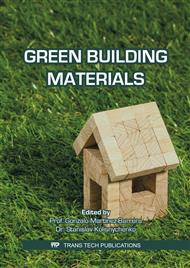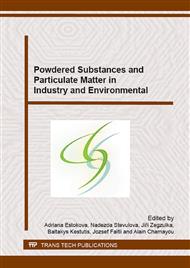[1]
K. Nkansah, B. Dawson-Andoh, J. Slahor, Rapid characterization of biomass using near infrared spectroscopy coupled with multivariate data analysis: Part 1 yellow-poplar (Liriodendron tulipifera L. ), Bioresource Technol. 101 (2010) 4570-4576.
DOI: 10.1016/j.biortech.2009.12.046
Google Scholar
[2]
G.H.D. Tonoli, M.N. Belgacem, G. Siqueira, J. Bras, H. Savastano, F.R. Lahr, Processing and dimensional changes of cement based composites reinforced with surface-treated cellulose fibres, Cement Concrete Comp. 37 (2013) 68-75.
DOI: 10.1016/j.cemconcomp.2012.12.004
Google Scholar
[3]
M.N. Belgacem, A. Gandini, Monomers, polymers and composites from renewable resources, Elsevier, Amsterdam, (2008).
Google Scholar
[4]
T. Sabu, L. Pothan, Cellulose fibre reinforced polymer composites, Old City Publishing, Philadelphia, (2008).
Google Scholar
[5]
J.H. Savastano, V.M. John, V. Agopyan, A. Moslemi, Special issue on inorganic bonded fiber composites, Constr. Build. Mater. 24 (2010) 129-220.
DOI: 10.1016/j.conbuildmat.2009.08.035
Google Scholar
[6]
Y. Hamzeh, K.P. Ziabari, J. Torkaman, A. Ashori, M. Jafari, Study on the effects of white rice husk ash and fibrous materials additions on some properties of fiber–cement composites, J. Environ. Manage. 117 (2013) 263-267.
DOI: 10.1016/j.jenvman.2013.01.002
Google Scholar
[7]
J.L. Pehanich, P.R. Blankenhorn, M.R. Silsbee, Wood fiber surface treatment level effects on selected mechanical properties of wood fiber–cement composites, Cement Concrete Res. 34 (2004) 59-65.
DOI: 10.1016/s0008-8846(03)00193-5
Google Scholar
[8]
J. Torkaman, A. Ashori, A.S. Momtazi, Using wood fiber waste, rice husk ash and limestone powder waste as cement replacement materials for lightweight concrete blocks, Constr. Build. Mater. 50 (2014) 432-436.
DOI: 10.1016/j.conbuildmat.2013.09.044
Google Scholar
[9]
M. Ardanuy, J. Claramunt, R.D. Toledo Filho, Cellulosic fiber reinforced cement-based composites: A review of recent research, Constr. Build. Mater. 79 (2015) 115-128.
DOI: 10.1016/j.conbuildmat.2015.01.035
Google Scholar
[10]
F. Xu, J. Yu, T. Tesso, F. Dowell, D. Wang, Qualitative and quantitative analysis of lignocellulosic biomass using infrared techniques: a mini-review, Appl. Energ. 104 (2013) 801-809.
DOI: 10.1016/j.apenergy.2012.12.019
Google Scholar
[11]
E. Smidt, K. Böhm, M. Schwanninger, The Application of FT-IR Spectroscopy in Waste Management, Fourier Transforms - New Analytical Approaches and FTIR Strategies, InTech, Rijeka, (2011).
DOI: 10.5772/15998
Google Scholar
[12]
STN EN 1008: 2003, Mixing water concrete, Specification for sampling, testing and assessing the suitability of water, including water recovered from processes in the concrete industry, as mixing water for concrete.
DOI: 10.3403/02609198
Google Scholar
[13]
STN EN 12390-7: 2011, Testing hardened concrete, Part 7: Density of hardened concrete.
Google Scholar
[14]
STN EN 12390-3: 2010, Testing hardened concrete, Part 3: Compressive strength of test specimens.
Google Scholar
[15]
M.F. Rosa, E.S. Medeiros, J.A. Malmonge, K.S. Gregorski, D.F. Wood, L.H.C. Mattoso, S.H. Imam, Cellulose nanowhiskers from coconut husk fibers: Effect of preparation conditions on their thermal and morphological behaviour, Carbohyd. Polym. 81 (2010).
DOI: 10.1016/j.carbpol.2010.01.059
Google Scholar
[16]
M. Poletto, V. Pistor, M. Zeni, A.J. Zattera, Crystalline properties and decomposition kinetics of cellulose fibers in wood pulp obtained by two pulping processes, Polym. Degrad. Stabil. 96 (2011) 679-685.
DOI: 10.1016/j.polymdegradstab.2010.12.007
Google Scholar
[17]
J. Čigášová, E. Singovszká, Study of hemp shives modification by FTIR spectroscopy, in: Young Scientist 2012, 4th PhD. Student Conference of Civil Engineering and Architecture, Košice, 2012, 1-6.
Google Scholar
[18]
K. Fackler, J.S. Stevanic, T. Ters, B. Hinterstoisser, M. Schwanninger, L. Salmén, FT-IR imaging spectroscopy to loclise and characterise simultaneous and selective white rot decay within sprude wood cell, Holzforschung 65 (2011) 411-420.
DOI: 10.1515/hf.2011.048
Google Scholar
[19]
M. Poletto, H.L. Ornaghi Junior, A.J. Zattera, Native Cellulose: Structure, Characterization and Thermal Properties, Materials 7 (2014) 6105-6119.
DOI: 10.3390/ma7096105
Google Scholar
[20]
Z. Ahmad, S. Iis, Z. Halim, Z., N. Sarifuddin, Effect of Fiber Length Variations on Properties of Coir Fiber Reinforced Cement-Albumen Composite (CFRCC). IIUM Engineering Journal 12 (2011) 63-76.
DOI: 10.31436/iiumej.v12i1.116
Google Scholar
[21]
L. Kidalova, N. Stevulova, T. Geffert, 2014 Possibility of using wood pulp in the preparation of cement composites, Selected Scientific Papers – Journal of Civil Engineering 9 (2014) 51-58.
DOI: 10.2478/sspjce-2014-0006
Google Scholar



